NCERT Solutions for Exercise 11.1 Class 9 Maths Chapter 11 - Constructions
NCERT Solutions for Class 9 Maths Chapter 11: Constructions Exercise 11.1- Download Free PDF
NCERT Solutions for Class 9 Maths Chapter 11: Constructions Exercise 11.1- In Chapter 9th class maths exercise 11.1 answers Maths, titled "Constructions," you'll learn how to design perfect geometric shapes with only a compass and a straightedge. This amazing journey begins with ex 11.1 class 9 It assigns you tasks that need you to precisely produce various types of angles.
But don't worry, because the NCERT Solutions for this class 9 maths chapter 11 exercise 11.1 serve as helpful guides. They are created by professionals and include detailed, step-by-step instructions for each construction. Plus, you can get them for free in PDF format, so you can use them even if you don't have access to the internet. So, let us begin confidently mastering the art of geometry creations!
Along with Class 9 Maths chapter 11 exercise 11.6 the following exercise is also present.
** According to the revised NCERT Syllabus 2023-24 update, this chapter has been removed.
Download PDF of NCERT Solutions for Class 9 Maths Chapter 11 – Constructions Exercise 11.1
Access Constructions Class 9 Maths Chapter 11 Excercise: 11.1
Q1 Construct an angle of 90 o at the initial point of a given ray and justify the construction.
Answer:
The steps of construction to follow:
Step 1: Draw a ray OP.
Then, take O as the centre and any radius draw an arc cutting OP at Q.
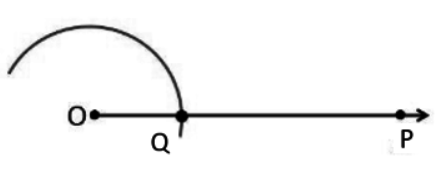
Step 2: Now, taking Q as the centre and with the same radius as before draw an arc cutting the previous arc at R. Repeat the process with R to cut the previous arc at S.
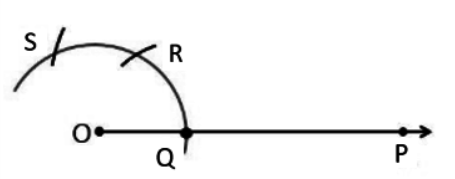
Step 3: Take R and S as centre draw the arc of radius more than the half of RS and draw two arcs intersecting at A. Then, join OA.
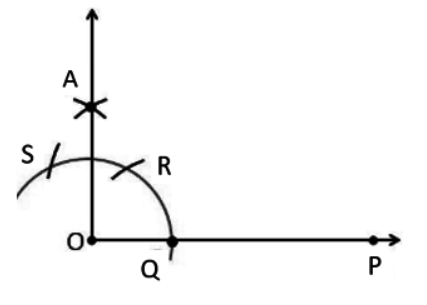
Hence, $\angle POA = 90^{\circ }$ .
Justification:
We need to justify, $\angle POA = 90^{\circ }$
So, join OR and OS and RQ. we obtain
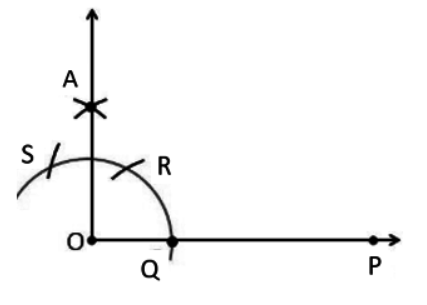
By construction OQ = OS = QR.
So, $\triangle ROQ$ is an equilateral triangle. Similarly $\triangle SOR$ is an equilateral triangle.
So, $\angle SOR = 60^{\circ}$
Now, $\angle ROQ = 60^{\circ}$ that means $\angle ROP = 60^{\circ}$ .
Then, join AS and AR:
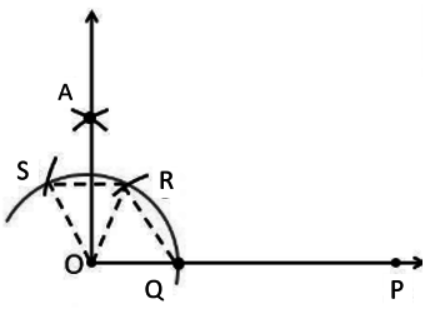
Now, in triangles OSA and ORA:
$SR = SR$ (common)
$AS = AR$ (Radii of same arcs)
$OS = OR$ (radii of the same arcs)
So, $\angle SOA = \angle ROA = \frac{1}{2}\angle SOR$
Therefore, $\angle ROA = 30^{\circ}$
and $\angle POA = \angle ROA+\angle POR = 30^{\circ} +60^{\circ} =90^{\circ}$
Hence, justified.
Q2 Construct an angle of 45 o at the initial point of a given ray and justify the construction.
Answer:
The steps of construction to follow:
Step 1: Draw a ray OY.
Then, take O as the centre and any radius, mark a point A on the arc ABC.

Step 2: Now, taking A as the centre and the same radius, mark a point B on the arc ABC.

Step 3: Take B as a centre and the same radius, mark a point C on the arc ABC.
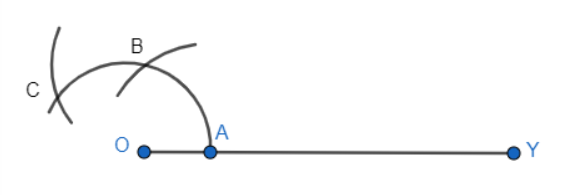
Step 4: Now, taking C and B as centre one by one, draw an arc from each centre intersecting each other at a point X.
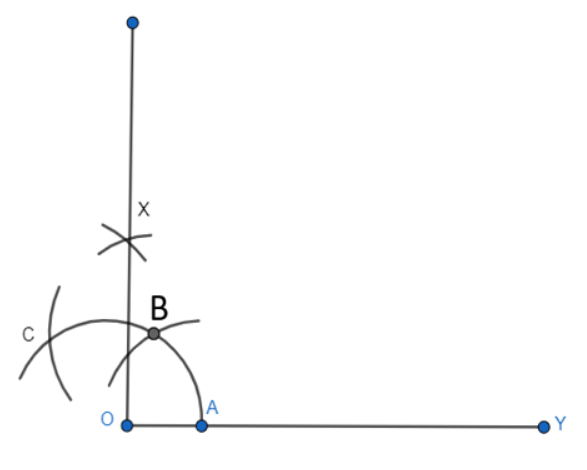
Step 5: X and O are joined and a ray making an angle $90^{\circ}$ with OY is formed.
Let the arc AC touches OX at E
Step 6: With A and E as centres, 2 arcs are marked intersecting each other at D and the bisector of angle XOY is drawn.
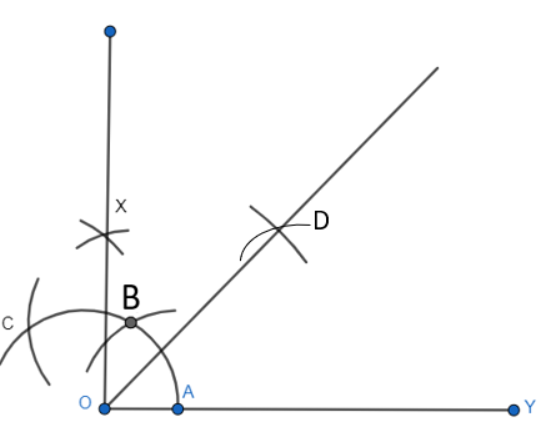
Justification:
By construction we have,
$\angle XOY = 90^{\circ}$
We constructed the bisector of $\angle XOY$ as $\angle DOY$
Thus,
$\angle DOY = \frac{1}{2}\angle XOY = \frac{1}{2}\times90^{\circ} = 45^{\circ}$
Q3 (i) Construct the angles of the following measurements: 30 o
Answer:
Steps to construction to follow:
Step 1: Draw a ray OY.

Step 2: Now, take A as a center and take any radius, then draw an arc AB cutting OY at A.

Step 3: Take A and B as centres, draw 2 arcs are marked intersecting each other at X and hence, the bisector of $30^{\circ}$ is constructed.
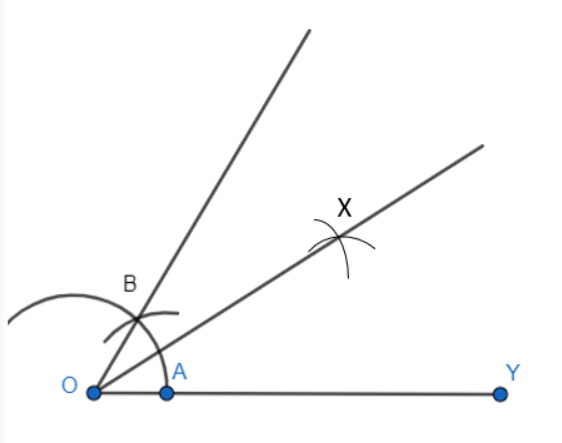
Thus, $\angle XOY$ is the required angle.
Q3.Construct the angles of the following measurements: (i) 30o
Edit Q
Q3 (ii) Construct the angles of the following measurements: $22\frac{1}{2}^\circ$
Answer:
Steps to construction to follow:
Step 1: Draw a ray OY.

Step 2: Now, take A as a centre and take any radius, then mark a point B on the arc

Step 3: Take B as a centre with the same radius, mark a point C on the arc ABC.
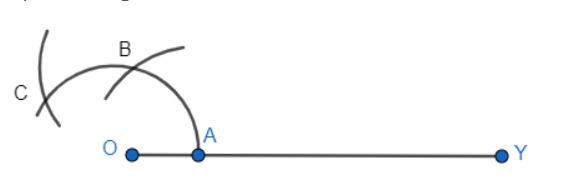
Step 4: Now, taking B and C as centres simultaneously, then draw an arc from each centre intersecting each other at a point X. Then join X and O and a ray making an angle with OY is formed.
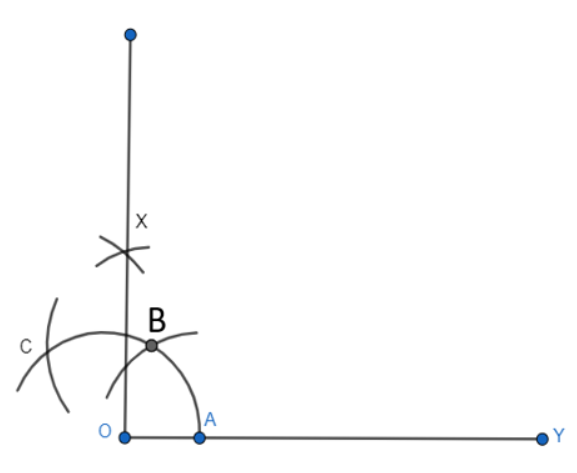
Let the arc AC touches OX at E
Step 5: Now, with A and E as centres, mark 2 arcs which intersect each other at D and we obtain the bisector of the angle $XOY$ .
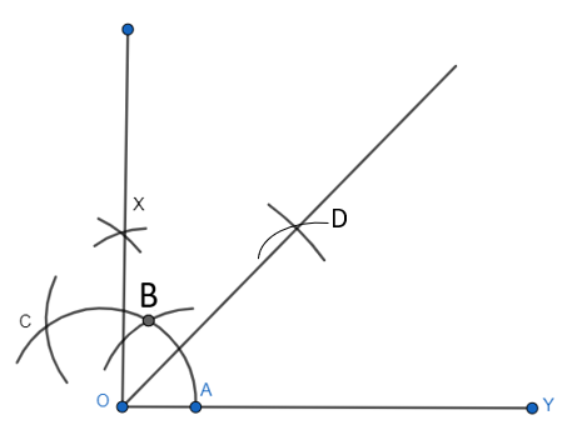
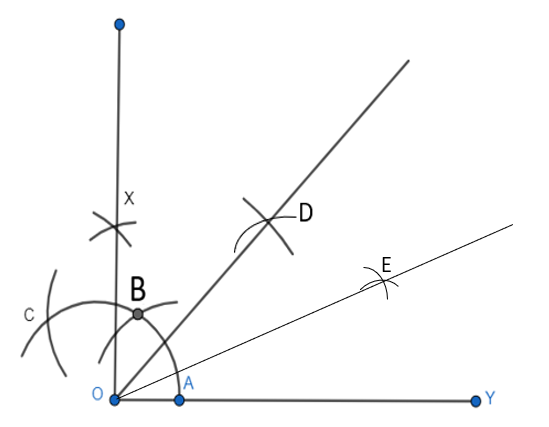
Q3 (iii) Construct the angles of the following measurements: 15 o
Answer:
Steps to construction to follow:
Step 1: Draw a ray OY.

Step 2: Now, take A as a centre and take any radius, draw an arc AB which cuts OY at A.

Step 3: Take A and B as a centre, then mark 2 arcs which intersect each other at X and Hence, the bisector is constructed of $30^{\circ}$ .
Step 4: Now, with A and E as centres, mark 2 arcs which intersect each other at D and we obtain the bisector of the angle $XOY$ .
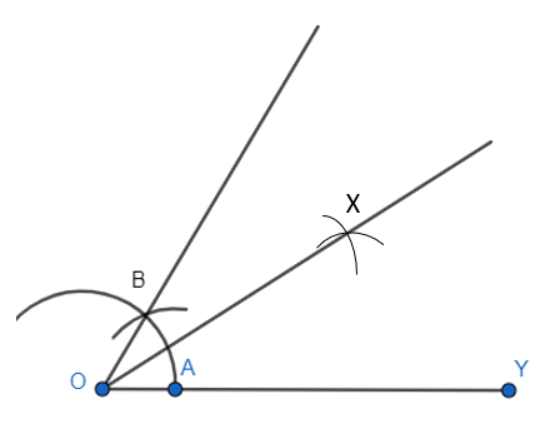
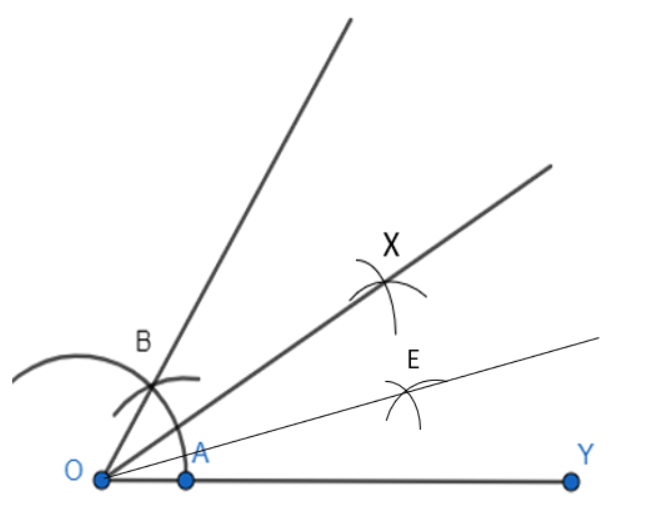
Thus, the angle of $15^{\circ}$ is obtained which is $\angle EOY.$
Q4 (i) Construct the following angles and verify by measuring them by a protractor: 75 o
Answer:
Steps to construction to follow:
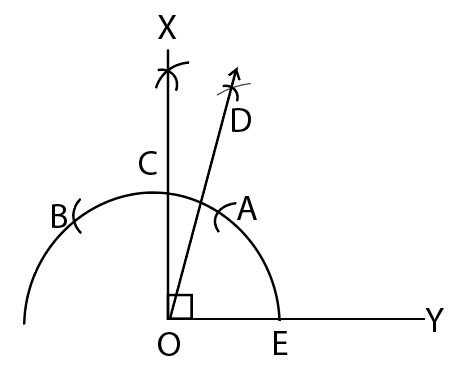
Step 1: Draw a ray OY.
Step 2: Now, taking O as the centre draw an arc ABC.
Step 3: On taking A as a centre, draw two arcs B and C on the arc ABC.
Step 4: Now, taking B and C as centres, arcs are made to intersect at point E and the $\angle EOY = 90^{\circ}$ is constructed.
Step 5: Taking A and C as centres, arcs are made to intersect at D.
Step 6: Now, join OD and hence, $\angle DOY = 75^{\circ}$ is constructed.
Hence, $\angle DOY$ is the required angle.
Q4 (ii) Construct the following angles and verify by measuring them by a protractor: 105 o
Answer:
The steps of construction to be followed:
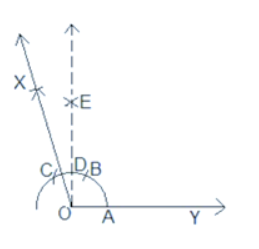
Step 1: Draw a ray OY.
Step 2: Then, taking O as a centre, draw an arc ABC.
Step 3: Now, with A as a centre, draw two arcs B and C which are made on the arc ABC.
Step 4: Taking B and C as centres simultaneously, arcs are made to intersect at E and $\angle EOY =90^{\circ}$ is constructed.
Step 5: With B and C as centres, arcs are made to intersect at X.
Step 6: Join the OX and we get $\angle XOY =105^{\circ}$ is constructed.
Thus, the angle $XOY$ is $105^{\circ}.$
Q4 (iii) Construct the following angles and verify by measuring them by a protractor: 135 o
Answer:
The steps of construction to be followed:
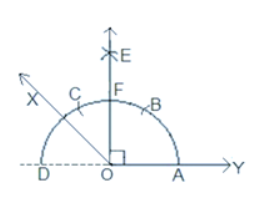
Step 1: Draw a ray DY.
Step 2: Draw an arc ACD with O as a center.
Step 3: Now, with A as a centre, draw two arcs B and C on the arc ACD.
Step 4: Taking B and C as centres, arcs are made to intersect at E and the angle formed is $\angle EOY = 90^{\circ}$ .
Step 5: Take F and D as centres, draw arcs to intersect at point X or the bisector of angle EOD is made.
Step 6: Join OX and the $\angle XOY = 135^{\circ}$ is made.
Hence, the angle required $\angle XOY$ is $135^{\circ}$ .
Q5 Construct an equilateral triangle, given its side and justify the construction.
Answer:
The following steps to make an equilateral triangle:
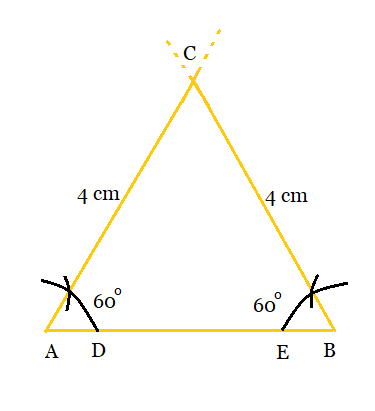
Step 1: Draw a line segment AB = 4 cm.

Step 2: With A and B as centres, make two arcs in the line segment AB. Mark it as D and E respectively.

Step 3: Now, with D and E as centres, make the two arcs cutting the previous arcs respectively, and forming an angle of $60^{\circ }$ each.
Step 4: Extend the lines of A and B until they intersect each other at point C.
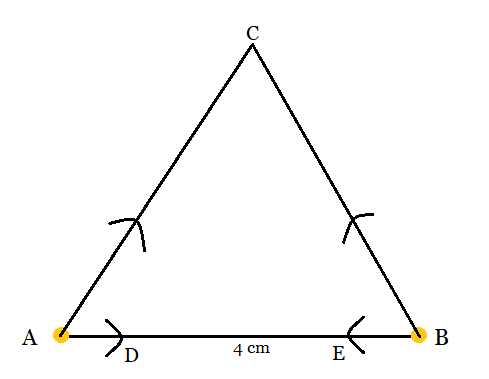
Hence, triangle constructed is ABC which is equilateral.
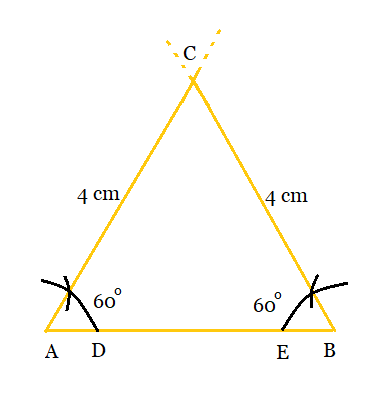
Now, Justification ;
Since the angles constructed are of $60^{\circ }$ each, so the third angle will also be $60^{\circ }$ .
$\left [ \because The\ sum\ of\ all\ angles\ of\ triangle = 180^{\circ} \right ]$
Q5 Construct an equilateral triangle, given its side and justify the construction.
Answer:
The following steps to make an equilateral triangle:

Step 1: Draw a line segment AB = 4 cm.

Step 2: With A and B as centres, make two arcs in the line segment AB. Mark it as D and E respectively.

Step 3: Now, with D and E as centres, make the two arcs cutting the previous arcs respectively, and forming an angle of $60^{\circ }$ each.
Step 4: Extend the lines of A and B until they intersect each other at point C.

Hence, triangle constructed is ABC which is equilateral.

Now, Justification ;
Since the angles constructed are of $60^{\circ }$ each, so the third angle will also be $60^{\circ }$ .
$\left [ \because The\ sum\ of\ all\ angles\ of\ triangle = 180^{\circ} \right ]$
This chapter and NCERT Solutions for Class 9 Maths exercise 11.1 are majorly based on the construction like construction of angle, side bisectors and angle bisector.
NCERT solutions for exercise 11.1 Class 9 Maths chapter 11 provides us the basic core concepts which includes the construction of triangles parallelograms circles and many different complex figures which are majorly from standard 10 perspectives.
In order to drawn an angle bisector as described in NCERT solutions for Class 9 Maths chapter 11 exercise 11.1, we first draw an arc that cuts both the sides of the angle then we draw two arcs of keeping their radius larger. Thus, then we join the point where these two new arcs meet to the point of the centre of the angle this line formed is called as the angle bisector.
Figure below shows the formation of an angle bisector by following the steps from exercise 11.1 Class 9 Maths
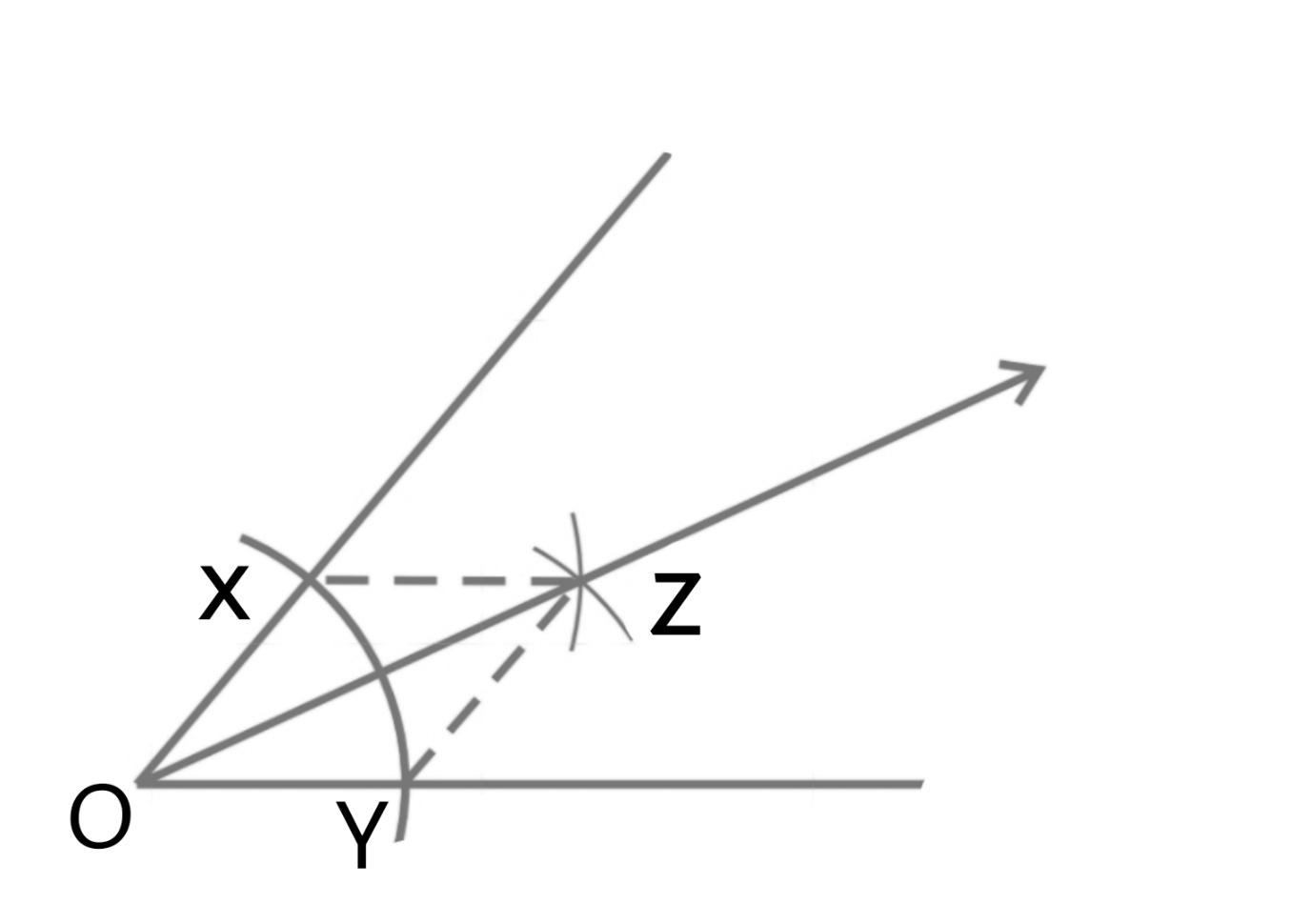
We follow simply this type of procedure in order to get the side bisector also
More About NCERT Solutions for Class 9 Maths Exercise 11.1
From NCERT solutions for Class 9 Maths exercise 11.1 we learn how to draw general angles for example 60 degrees. We got to know from Class 9 Maths chapter 11 exercise 11.1 that In order to draw an angle of 60 degree we first take a line mark two points at the name A&B then from A we draw an arc taking an approximation more than 60 degree and then from B we draw an arc which cuts the arc drone with centre a note that the arc radius of both the arcs drawn is equal to AB.
This we join the point a as we have taken it as the centre of the angle to the cutting point of our court the intersection points of Arc marked as X then we draw the line this angle formed is equal to 60 degrees.
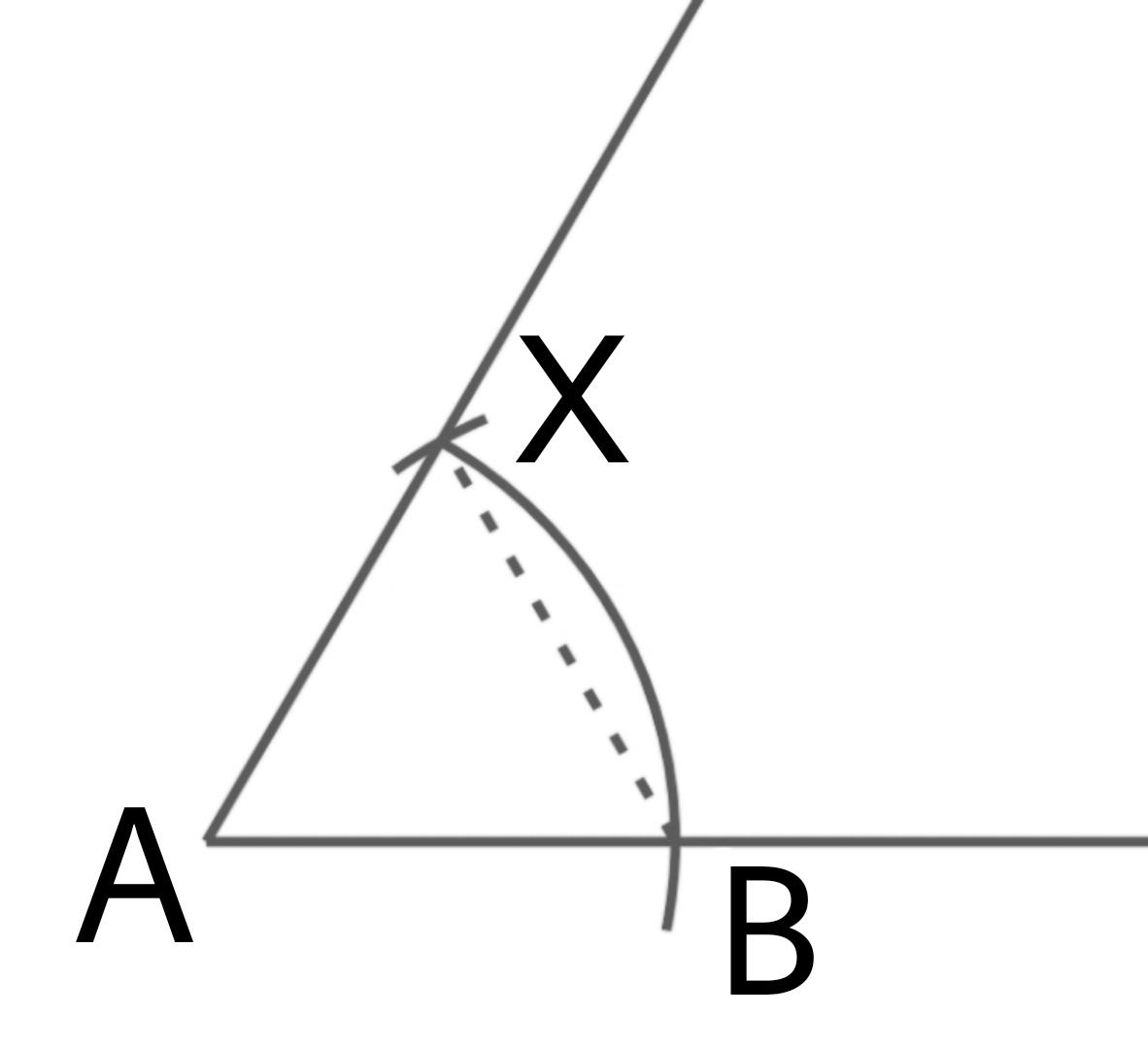
Also Read| Constructions Class 9 Notes
Benefits of NCERT Solutions for Class 9 Maths Exercise 11.1
Class 9 Maths chapter 11 exercise 11.1, is based construction and most of the crucial implication of construction.
From Class 9 Maths chapter 11 exercise 11.1 we get to learn the construction of general angles.
Understanding the concepts from NCERT solutions for Class 9 Maths exercise 11.1 will make the ideas and question from better expectations (like Class 10) simpler for us.
key Features of Class 9 Maths Chapter 11 Exercise 11.1
Step-by-Step Solutions: NCERT Solutions for class 9 maths ex 11.1 step-by-step instructions for each construction problem. This helps students follow the process with ease.
Clear and Concise: 9th class maths exercise 11.1 answers are written in clear and concise language, making it accessible for students of all levels.
Accessible PDF Format: The ex 11.1 class 9 solutions are available for free download in PDF format, allowing students to access them offline and at their convenience.
Concept Reinforcement: This class 9 ex 11.1 reinforces students' understanding of geometrical concepts and helps develop their construction skills, fostering attention to detail.
Preparation for Advanced Topics: The constructions taught in this chapter are foundational for more advanced topics in geometry that students will encounter in higher classes.
Also, See
NCERT Solutions of Class 10 Subject Wise
Courses After 12th
Applications for Admissions are open.
As per latest syllabus. Physics formulas, equations, & laws of class 11 & 12th chapters
JEE Main Important Chemistry formulas
Get nowAs per latest syllabus. Chemistry formulas, equations, & laws of class 11 & 12th chapters
JEE Main high scoring chapters and topics
Get nowAs per latest 2024 syllabus. Study 40% syllabus and score upto 100% marks in JEE
JEE Main Important Mathematics Formulas
Get nowAs per latest syllabus. Maths formulas, equations, & theorems of class 11 & 12th chapters
